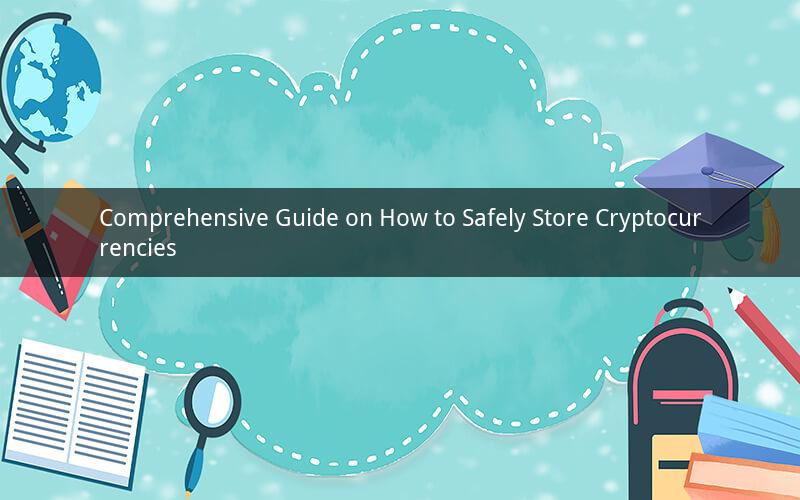
Introduction:
As cryptocurrencies continue to gain popularity, the need for secure storage solutions has become paramount. Whether you are a seasoned investor or a beginner, understanding how to store cryptocurrencies is crucial to protect your digital assets. This guide will explore various methods of storing cryptocurrencies, their pros and cons, and provide you with the knowledge to make an informed decision.
1. Hardware Wallets:
Hardware wallets are considered one of the most secure ways to store cryptocurrencies. These devices store your private keys offline, making them immune to online hacking attempts. Here's how to use a hardware wallet:
a. Choose a reputable hardware wallet: Research and select a well-established and trusted hardware wallet manufacturer, such as Ledger or Trezor.
b. Set up your hardware wallet: Follow the manufacturer's instructions to set up your hardware wallet. This typically involves connecting the device to your computer, installing the necessary software, and creating a PIN.
c. Generate a new wallet: Use the hardware wallet to generate a new wallet address for your cryptocurrency. This address will be used to receive and send funds.
d. Backup your wallet: Create a backup of your hardware wallet by following the manufacturer's instructions. This backup will be essential if you lose your device or need to recover your funds.
2. Software Wallets:
Software wallets are digital applications that allow you to store, send, and receive cryptocurrencies. They are available in various forms, including mobile, desktop, and web wallets. Here's how to use a software wallet:
a. Choose a software wallet: Select a reputable software wallet that supports the cryptocurrencies you own. Consider factors such as ease of use, security features, and compatibility with your device.
b. Install the software wallet: Download and install the software wallet on your device. Follow the instructions provided by the wallet provider to set up your account.
c. Generate a new wallet: Use the software wallet to generate a new wallet address for your cryptocurrency. This address will be used to receive and send funds.
d. Backup your wallet: Create a backup of your software wallet by following the instructions provided by the wallet provider. This backup will be essential if you lose your device or need to recover your funds.
3. Paper Wallets:
Paper wallets are physical pieces of paper that contain your private and public keys. They are considered secure because they are not connected to the internet. Here's how to create a paper wallet:
a. Generate a new wallet: Use a reputable online tool or software to generate a new wallet with a private and public key.
b. Print the wallet: Print the private and public keys on a high-quality printer. Ensure that the paper is not prone to smudging or tearing.
c. Store the wallet securely: Keep the paper wallet in a safe and secure location, such as a safe deposit box or a fireproof safe.
4. Exchanges:
Many cryptocurrency exchanges offer storage solutions for their users. While exchanges are convenient, they are not the most secure option. Here's how to use an exchange for storing cryptocurrencies:
a. Choose a reputable exchange: Research and select a well-established and trusted cryptocurrency exchange.
b. Create an account: Sign up for an account on the exchange and complete the necessary verification process.
c. Deposit your cryptocurrencies: Transfer your cryptocurrencies to the exchange's wallet address.
d. Withdraw your cryptocurrencies: When you're ready to withdraw your funds, follow the exchange's instructions to transfer them to your preferred storage method.
Frequently Asked Questions:
1. Q: Can I store multiple cryptocurrencies in a single wallet?
A: Yes, many software wallets and hardware wallets support multiple cryptocurrencies. Ensure that the wallet you choose supports the cryptocurrencies you own.
2. Q: How do I recover my cryptocurrencies if I lose my private key?
A: If you lose your private key, you will lose access to your cryptocurrencies. It is crucial to create backups of your private keys and store them securely.
3. Q: Are paper wallets completely secure?
A: While paper wallets are considered secure, they are not immune to physical damage or loss. Store them in a safe and secure location to minimize the risk of loss.
4. Q: Can I use the same wallet for storing all my cryptocurrencies?
A: It is generally recommended to use separate wallets for different cryptocurrencies, as this can help you manage your assets more effectively and reduce the risk of losing them.
5. Q: Is it safe to store cryptocurrencies on an exchange?
A: While exchanges offer convenience, they are not the most secure option. It is advisable to use exchanges only for short-term storage and transfer your cryptocurrencies to a more secure storage method, such as a hardware wallet, as soon as possible.
Conclusion:
Storing cryptocurrencies securely is essential to protect your digital assets. By understanding the different storage methods available, you can make an informed decision on how to store your cryptocurrencies. Whether you choose a hardware wallet, software wallet, paper wallet, or exchange, always prioritize security and take the necessary precautions to safeguard your digital wealth.